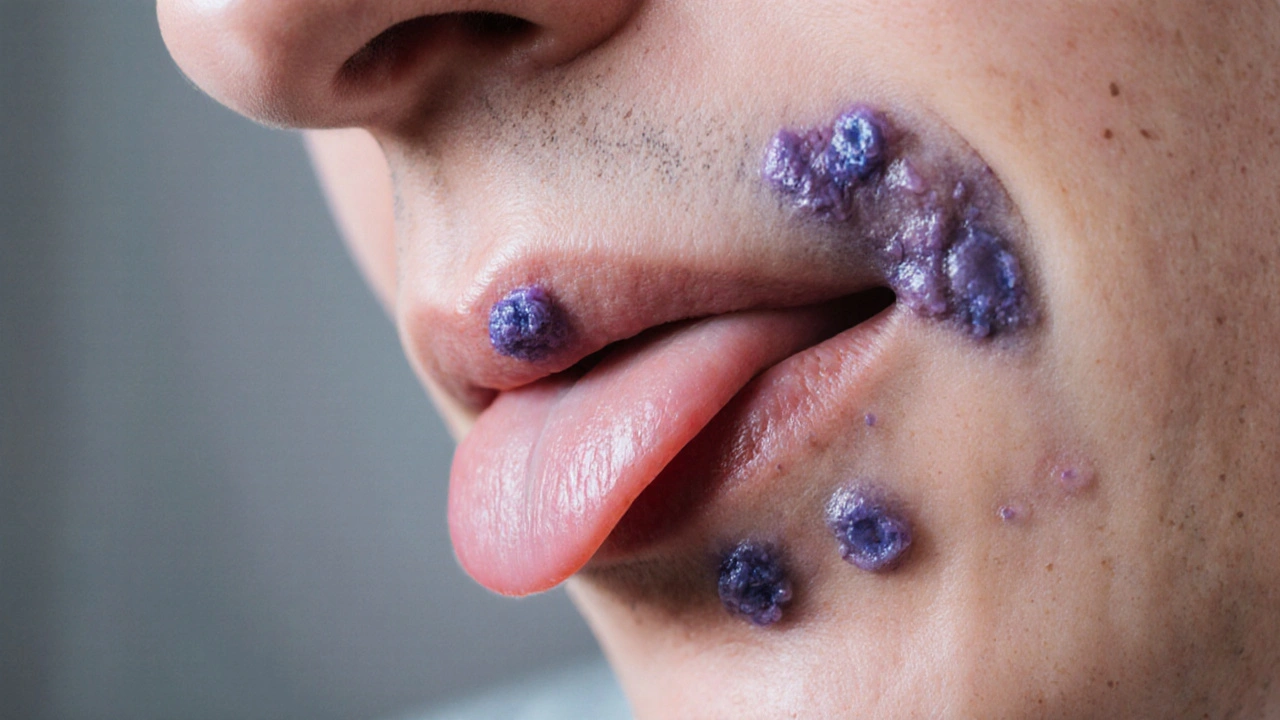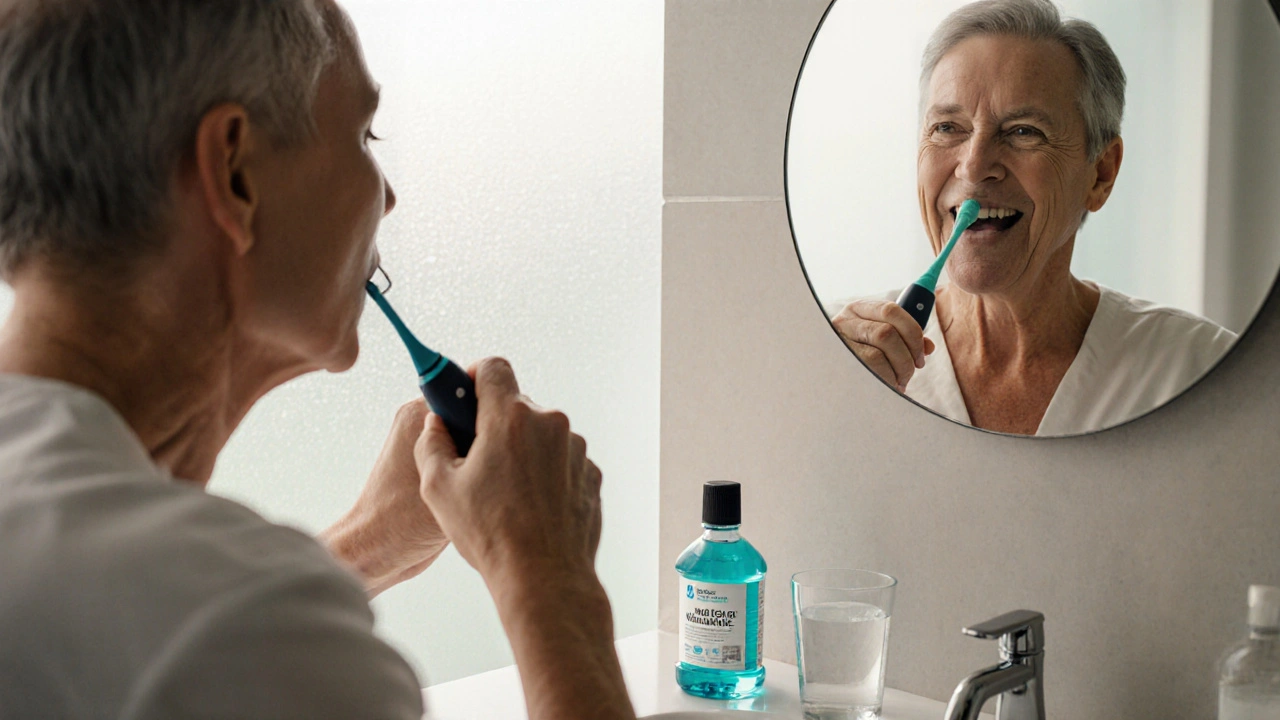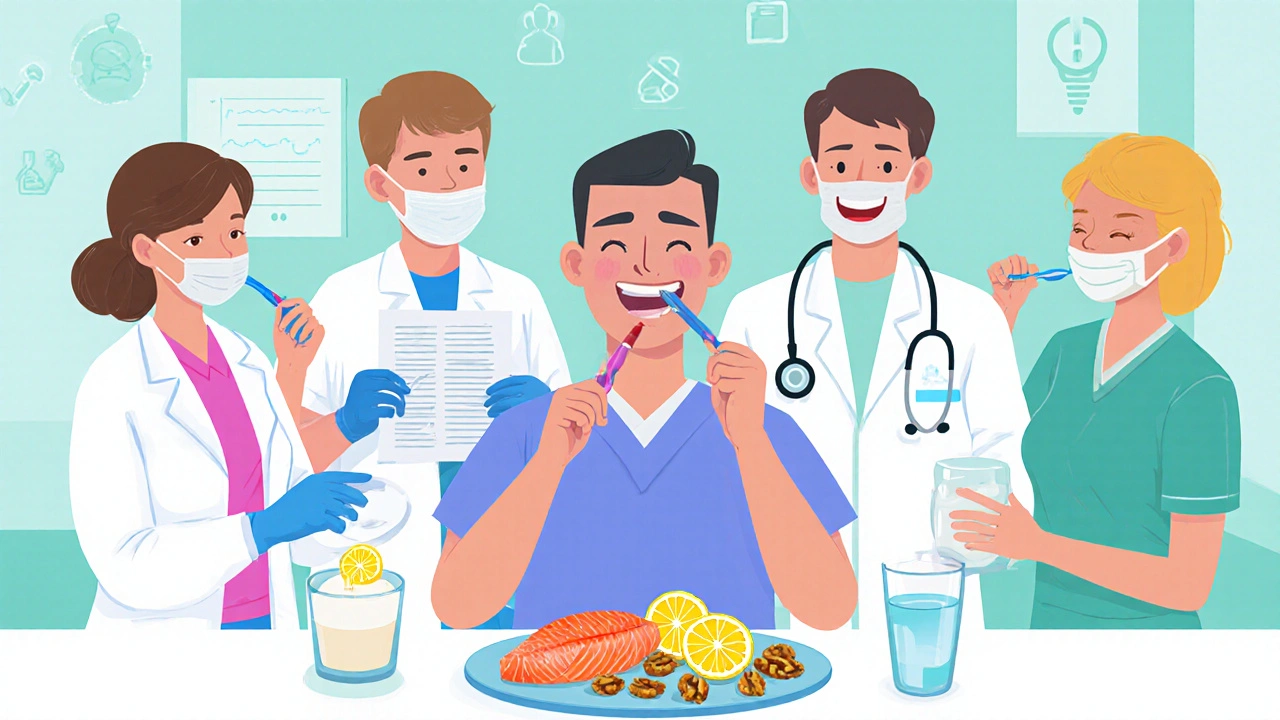Kaposi Sarcoma Oral Care: Dental Health Tips for Patients
 Oct, 12 2025
Oct, 12 2025
KS Oral Care Phase Guide
Choose Your Treatment Phase
Select your current treatment stage to see personalized oral care recommendations
Pre-treatment
Before starting chemotherapy or antiretroviral therapy
During treatment
While undergoing chemotherapy or antiretroviral therapy
Post-treatment
After completing treatment or in remission
Pre-treatment
- Full dental exam and cleaning
- Treat existing cavities or gum disease
- Take oral photos for baseline
Reduces infection risk once chemotherapy starts
During treatment
- Brush twice daily with a soft-bristled toothbrush
- Use alcohol-free fluoride mouthwash
- Rinse after every meal if you have dry mouth
- Inspect tongue and palate for new lesions
Prevents plaque buildup that can hide KS spots and cuts down on bleeding
Post-treatment
- Continue bi-annual dental visits
- Monitor for recurrence of oral KS
- Maintain adequate hydration and nutrition
Early detection of a new lesion can spare you from aggressive therapy later
- New or expanding purple/blue lesions
- Persistent bleeding that won't stop after 10 minutes
- Severe pain that interferes with eating
- Signs of infection (swelling, pus, fever)
- Brush gently with soft-bristled brush and fluoride toothpaste for 2 minutes
- Rinse with alcohol-free mouthwash or saline solution
- Floss once daily using floss threader if needed
- Check tongue, palate, and gums for new spots; photograph changes
- Stay hydrated with water throughout the day
- Take prescribed antifungal or antiviral lozenges as directed
Living with Kaposi sarcoma is a daily balancing act, and the mouth often gets overlooked until a problem shows up. The good news is that a few focused habits can keep your smile healthy while your body fights the disease.
What is Kaposi Sarcoma and How It Affects the Mouth
Kaposi sarcoma is a cancer that originates from the cells lining blood vessels. It most commonly appears on the skin, but lesions can also develop inside the oral cavity, especially on the palate, gums, and tongue. When the immune system is weakened-by HIV, organ transplantation, or chemotherapy-the virus that drives KS (Human Herpesvirus‑8) spreads more easily, leading to more frequent mouth lesions.
Why Dental Health Matters for People With KS
Oral health isn’t just about a bright smile. For anyone with Kaposi sarcoma, poor dental hygiene can:
- Increase the risk of secondary infections that complicate treatment.
- Make ulcerated KS lesions painful, limiting the ability to eat and take medication.
- Trigger bleeding, which is especially risky if you’re on blood‑thinning drugs.
Key Players in Your Oral‑Care Team
Think of oral health as a team sport. Here are the main specialists you’ll likely interact with:
- Dentist - Provides routine cleanings, monitors lesions, and manages periodontal disease.
- Oral surgeon - May be needed for biopsy or removal of large KS lesions.
- Oncologist - Coordinates cancer‑directed therapy such as chemotherapy or antiretroviral treatment.
- Infectious disease specialist - Helps manage opportunistic infections like oral thrush.

Oral Care Routine Before, During, and After Treatment
Each phase of KS management brings different challenges. Below is a quick‑reference checklist that adapts as your treatment evolves.
| Phase | Key Actions | Why It Matters |
|---|---|---|
| Pre‑treatment |
|
Reduces infection risk once chemotherapy starts. |
| During chemotherapy / antiretroviral therapy |
|
Prevents plaque buildup that can hide KS spots and cuts down on bleeding. |
| Post‑treatment (remission or maintenance) |
|
Early detection of a new lesion can spare you from aggressive therapy later. |
Managing Specific Oral Problems Linked to Kaposi Sarcoma
Oral Lesions: KS lesions appear as raised, purplish plaques or nodules. If they bleed, apply a gentle pressure with a clean gauze. Ask your dentist about topical agents that can protect the area while it heals.
Oral thrush (Candida overgrowth) is common when the immune system is low. Antifungal mouth rinses, sugar‑free lozenges, and strict oral hygiene usually clear it within two weeks.
Dry mouth (xerostomia) can be a side‑effect of chemotherapy or certain HIV meds. Stimulate saliva with sugar‑free gum, sip water regularly, and consider saliva substitutes if dryness interferes with speaking or swallowing.
Periodontal disease often worsens under immunosuppression. Floss gently after each meal, use an antimicrobial mouthwash, and keep a calendar for professional cleanings every six months.
Nutrition and Lifestyle Tips That Support Oral Health
What you eat directly affects your gums and lesions. Aim for:
- High‑protein foods (lean meat, beans, Greek yogurt) to help tissue repair.
- VitaminC‑rich fruits (citrus, kiwi) for collagen strength.
- Omega‑3 fatty acids (salmon, walnuts) that reduce inflammation.
- Avoiding very hot, spicy, or acidic foods that can irritate KS plaques.

When to Call Your Dentist or Doctor
Set a low threshold for reaching out. Contact a dental professional if you notice:
- New or expanding purple/blue lesions.
- Persistent bleeding that won’t stop after 10 minutes.
- Severe pain that interferes with eating.
- Signs of infection such as swelling, pus, or fever.
Common Myths About KS and Dental Care
Myth: “If I have oral KS, I should avoid the dentist.” Fact: Regular dental visits catch problems early, reduce infection risk, and can even spot lesions that need a biopsy.
Myth: “Mouth rinses will cure KS.” Fact: Rinses control secondary infections and keep the mouth clean, but they don’t treat the underlying cancer.
Myth: “I don’t need floss because I have a soft‑bristled brush.” Fact: Floss removes plaque from between teeth where a brush can’t reach, protecting gums that are already vulnerable.
Putting It All Together: A Simple Daily Routine
- Brush gently with a soft brush and fluoride toothpaste for two minutes.
- Rinse with an alcohol‑free mouthwash that contains chlorhexidine (if prescribed) or plain saline.
- Floss once a day, using a floss threader if you have braces or dentures.
- Check your tongue, palate, and gums for any new spots; photograph any changes.
- Sip water after meals and keep a small bottle handy.
- Take any prescribed antifungal or antiviral lozenges as directed.
Stick to this routine, keep your appointments, and you’ll give your body the best chance to manage KS without letting oral problems derail you.
Frequently Asked Questions
Can Kaposi sarcoma lesions turn into oral cancer?
KS lesions are vascular tumors, not squamous cell carcinomas. However, chronic irritation or infection can increase the risk of separate oral cancers, so regular dental monitoring remains essential.
Is it safe to get a dental cleaning while on chemotherapy?
Yes, as long as your blood counts (especially neutrophils and platelets) are within safe ranges. Your oncologist can issue a clearance note before the appointment.
What type of toothbrush works best for KS patients?
A soft‑bristled, rounded‑tip brush reduces trauma to fragile lesions. Some patients prefer an electric brush with a pressure sensor to avoid over‑scrubbing.
Should I avoid alcohol‑based mouthwashes?
Alcohol can dry out the mouth and irritate KS plaques. Choose alcohol‑free formulas, especially if you already experience xerostomia.
How often should I see my dentist if I have Kaposi sarcoma?
At minimum, schedule a check‑up every six months. If you’re on active chemotherapy or notice new oral lesions, a three‑month interval is advisable.

Ashley Helton
October 12, 2025 AT 05:28Wow, because nothing says “I trust my oncologist” like a soft‑bristled toothbrush, right? I love how the guide tells you to brush twice a day – that’s practically a marathon for a mouth that’s already under attack. And the alcohol‑free mouthwash suggestion? Pure genius, as if we needed more fancy names for water. Just remember to check your tongue for those lil’ purple spots – they’re the party guests nobody invited.
Carlise Pretorius
October 13, 2025 AT 13:06i think a soft brush is the way
Johnson Elijah
October 14, 2025 AT 20:46Let’s break down why this oral‑care playbook is a game‑changer for anyone fighting Kaposi sarcoma 🚀. First, a comprehensive dental exam before chemo isn’t just a formality – it’s the first line of defense against opportunistic infections 🛡️. Treating existing cavities removes a hidden reservoir of bacteria that could otherwise exploit a weakened immune system 🔬. Baseline photos give you a visual record, making it easier to spot subtle changes later on 📸. During treatment, brushing with a soft‑bristled brush twice daily protects delicate mucosa while still removing plaque 🪥. Switching to an alcohol‑free fluoride rinse keeps the mouth moist and cuts down on irritation from the lesions 🌿. Rinsing after every meal, especially if you suffer from dry mouth, washes away food particles that could foster fungal growth 🍽️. Daily inspection of the tongue and palate acts as a self‑diagnostic tool, catching new KS spots before they bleed 🎯. If you notice a purple lesion, applying gentle pressure with gauze can control bleeding while you arrange an urgent dental visit 🩸. Hydration isn’t just about quenching thirst; plenty of water fuels saliva production, which naturally cleanses the oral cavity 💧. Nutrient‑dense foods like lean protein and vitamin‑C‑rich fruits supply the building blocks for tissue repair and immune resilience 🍗🍊. Omega‑3 fatty acids from salmon or walnuts reduce systemic inflammation, indirectly supporting oral health 🐟🥜. Avoiding overly hot, spicy, or acidic foods prevents additional trauma to fragile KS plaques 🔥. Consistent bi‑annual dental check‑ups after treatment keep the surveillance loop tight, catching recurrences early 🗓️. Finally, clear communication with your oncologist about any oral changes ensures your systemic therapy can be adjusted promptly, preventing complications 🗣️. Follow this routine, stay vigilant, and you’ll give your body the best shot at managing KS without letting your mouth become a secondary battlefield 😎.
Roxanne Lemire
October 16, 2025 AT 04:26That is a lot of info i cant keep up but i get the point brush soft and check daily
Alex Mitchell
October 17, 2025 AT 12:06Thanks for the thorough rundown – it’s reassuring to see how each step ties into overall health :) I especially appreciate the reminder about baseline photos, they’re a simple yet powerful tool. Keeping hydrated and choosing the right mouthwash seems straightforward but so often overlooked. It’s good to know that regular dental visits are safe with proper blood count checks.
Narayan Iyer
October 18, 2025 AT 19:46Absolutely, the integration of odontogenic prophylaxis within the oncologic protocol exemplifies a multidisciplinary approach, leveraging both prophylactic dentistry and pharmacologic adjuncts. Utilizing chlorhexidine as a targeted antiseptic aligns with evidence‑based practices, mitigating biofilm formation while preserving mucosal integrity. Moreover, the pharmacokinetic considerations of antifungal lozenges complement systemic ARV therapy, ensuring synergistic efficacy. In summary, this regimen operationalizes a holistic, evidence‑driven framework that optimizes patient outcomes.
Amanda Jennings
October 20, 2025 AT 03:26Just wanted to shout out how practical the daily routine list is – it’s like having a cheat‑sheet for staying on top of oral health while dealing with KS. The emphasis on soft brushing and saliva stimulation really resonates, especially for those of us who battle dry mouth. Keep the tips coming!
alex cristobal roque
October 21, 2025 AT 11:06Totally get you, Amanda! I’ve been juggling chemo cycles and trying to remember when I last flossed, so having that step‑by‑step checklist feels like a lifesaver. I mean, checking the tongue for new spots might sound like a weird habit, but once you actually see a tiny discoloration, you realize it can save you a lot of trouble down the road. Plus, sipping water after every meal isn’t just good for the gums – it also keeps you from feeling like you’re chewing on a desert. I also appreciate the reminder about nutrition; loading up on protein and Vitamin C has honestly helped my energy levels bounce back quicker after treatment. And yeah, using an alcohol‑free mouthwash is way better than the harsh ones that leave your mouth feeling like a desert. All in all, these simple tweaks add up to a big difference in how we feel day‑to‑day.
Bridget Dunning
October 22, 2025 AT 18:46Dear colleagues, I wish to commend the authors for presenting a meticulously structured oral‑care protocol that integrates both preventive and therapeutic measures for patients afflicted with Kaposi sarcoma. The delineation of phase‑specific recommendations, accompanied by clear rationales, facilitates implementation across multidisciplinary teams. Furthermore, the inclusion of nutritional guidance underscores the holistic perspective requisite for optimal patient outcomes. I trust that this resource will prove invaluable to clinicians and patients alike.
Shweta Dandekar
October 24, 2025 AT 02:26Indeed, the articulation of such comprehensive guidelines is not merely beneficial-it is an ethical imperative!!! By emphasizing preventive dentistry, we uphold the moral responsibility to safeguard vulnerable patients from avoidable complications; furthermore, the rigorous recommendation of regular bi‑annual examinations reflects an unwavering commitment to patient welfare!!! Let us all champion these standards, for the health of our community depends upon such diligent stewardship.
Gary Smith
October 25, 2025 AT 10:06America leads the world in medical innovation, and this guide proves we set the gold standard for patient care!!! No other nation offers such thorough, battle‑tested oral‑health protocols for Kaposi sarcoma-our doctors, our dentists, our scientists are unmatched!!! Let’s keep supporting our home‑grown expertise and demand the same excellence worldwide!!!
mike putty
October 26, 2025 AT 17:46We can all appreciate the dedication behind these guidelines, regardless of where they originate. Sharing best practices helps everyone improve, and that’s a win‑win for patients worldwide. Let’s stay focused on the science and keep supporting each other.